Last Updated on January 20, 2024 by Greg Gillson
Feeding backyard birds is a popular winter pastime. It is the perfect combination of indoor/outdoor activity. Enjoy the outdoors from the comfort of your warm home!
Are you thinking about trying bird feeding for the first time? Or, perhaps, you have tried it, but are looking for some tips for making your winter bird feeding adventure more successful and enjoyable.
This article tells why and how to set up a bird feeder in New Jersey in the winter. I’ll also show you photos of the common feeder birds in New Jersey that you can look for at your own backyard feeder! I will give brief identification tips. I will tell you what foods and what type of feeders attract each species.
Winters are fairly cold in New Jersey. The northwestern part of the state is colder than the more mild coastal areas. Winter temperatures generally range from a high of 34-43° F and a low of 16-28° F.
Snowfall can happen October to April. It ranges from 40-50 inches in the north to 10-15 inches in the south.
Despite the cold winter weather, many birds spend the winter and will show up at your feeders. In fact, many of the birds found at your feeder in winter will remain in your backyard all year long.
Why feed winter birds in New Jersey?
Each type of bird follows its own species’ instinctive pattern to decide where to spend the winter. This has worked out for them for hundreds and even thousands of generations.
However, we have been experiencing very unstable weather patterns lately. These are expected to continue. These extreme weather events put stress on birds. This stress adds up. Eventually, it may mean that more and more birds don’t survive the winter.
You can help the birds survive the winter and bring joy to your life as well!
Watching and feeding birds helps people reconnect with nature. It reminds us that our actions–no matter how seemingly insignificant–can have real positive effects on the natural world.
You may not be able to save the world alone. But you are not alone. Millions of people feed birds. Millions of people care about the environment. This is one little thing you can do to make it better.
Do you have children or grandchildren? Feeding birds is a great way to bond with them.
Feeding winter birds teaches children about the interconnectedness of nature. It helps them get away from their electronic devices and look around at living things they share the planet with. Children are evermore disconnected from the natural world.
What birds come to feeders in winter in New Jersey?
In this section I will show the most common winter birds to come to feeders in New Jersey.
I include photos and brief descriptions. My hope is that you will learn these most common birds in your area.
Of course, you can feed birds without identifying them. But often, putting a name to something is the first step to getting to know it better. Caring.
I have also written another article on common backyard birds of New Jersey. That article includes birds all through the year. It also includes backyard birds that don’t necessarily eat at bird feeders. When you are done with this article, please check out The most common backyard birds of New Jersey. I’ll link to it again at the end of this article.
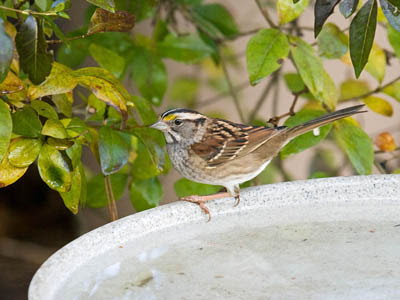 |
| White-throated Sparrow Photo by Greg Gillson |
White-throated Sparrow
This northern bird winters across much of the eastern United States.
They scratch in the leaves on the ground. When startled, they usually fly into low saplings, unlike other sparrows that dive into low dense bushes.
This woodland and brush-loving sparrow breeds across Canada and the extreme northeastern parts of the US. In winter they move south. They winter in the East and South. They are rare, but regular, along the West Coast.
White-throated Sparrows winter throughout New Jersey. This is just on the edge of their breeding range. A few birds may be found in higher elevations throughout the year.
They are longer than many other plump sparrows, with a long tail. The conical bill tells that they eat seeds.
They are striped tan and brown above. The breast is gray, contrasting strongly with a bright white throat. The head is striped tan-and-brown in juveniles and some adults. Other adults have head stripes of back-and-white. All ages and color forms have a bright spot of yellow feathers above the front of the eyes.
These birds may sing throughout the year, a plaintive whistle: Ole Sam Peabody, Peabody or Oh, Sweet Canada, Canada. They have a surprisingly loud chip! note frequently given at dawn and dusk.
White-throated Sparrows eat black oil sunflower seeds and some of the smaller mixed seeds. They will eat on platform and hopper feeders, but often clean up seeds on the ground spilled from the feeder above.
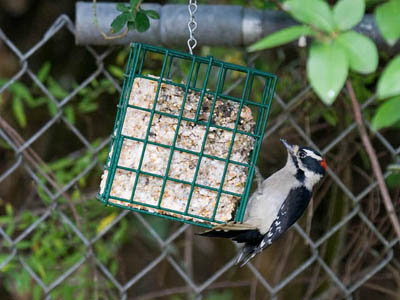 |
| Downy Woodpecker Photo by Greg Gillson |
Downy Woodpecker
These cute little birds frequent backyards and feeders. In winter singles or a pair often attach themselves to flocks of chickadees and other small songbirds.
They climb up small tree trunks, saplings, and branches. They often stay quite low. They peck at the bark, dislodging insects.
They are resident in deciduous woods and stream sides from Alaska, across Canada, and all of the United States except for desert lands.
Downy Woodpeckers are found year-round throughout New Jersey.
As with all woodpeckers, the body is stocky. The short tail is stiff pointed. The head is large. Unlike most woodpeckers, this species has a small stubby bill, rather than the typical longer chisel-shaped bill. They have strong legs and feet with which they cling to tree trunks and other surfaces.
These birds are black above, white below. The back is white. The wings are spotted with white. The tail is black with white outer tail feathers. The head is striped black and white. The male has a red spot on the back of the head which the female lacks.
In winter their call is a sharp pik note.
At the feeder they may eat small seeds or nuts, but are primarily attracted to the suet feeder.
 |
| Northern Cardinal Image by GeorgeB2 from Pixabay |
Northern Cardinal
This bird’s image seems to be on every bird feeder and bird seed package. And no wonder–it’s one of the most common backyard birds in the eastern and southern United States.
Cardinals often forage in low bushes or on the ground. In winter may be found in small flocks, often with other sparrows and juncos.
These birds live in woodlands, stream sides, and suburban gardens. They are found year-round in extreme southeastern Canada and across the eastern United states west to Minnesota and SE North Dakota, south through Texas, and from there west to Arizona and south through lowlands of Mexico.
Northern Cardinals are found year-round throughout New Jersey.
These are medium-large songbirds and fairly plump. They have a full rounded tail. The bill is very large and cone-shaped. The signature crest may be held obviously upright or slicked backed and inconspicuous.
Males are bright red with blackish face. Females are more subdued pale brownish. Both share the red bill and crested head.
The common call in winter is a loud chip. However, they sing year-round in whistled phrases repeated 3 times, such as cheer cheer cheer or birdy birdy birdy.
Northern Cardinals eat larger sunflower and safflower seeds from platform feeders or larger hopper feeders. They may frequently be seen on the ground under the feeder cleaning up any fallen seeds.
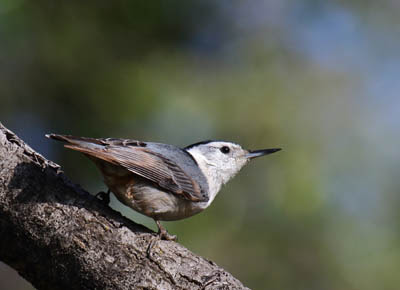 |
| White-breasted Nuthatch Photo by Greg Gillson |
White-breasted Nuthatch
Nuthatches are instantly identifiable as short tailed birds that walk head-first down the tree trunk.
They are also very acrobatic at your bird feeder. They grab a single large seed and then fly off to pound it open to eat or cache it away for eating later in winter.
These birds are found in deciduous trees in the East. In the West, they are found in oak and ponderosa pine forests. They are found across southern Canada, most of the United States except treeless deserts and grasslands, and through the mountains of Mexico.
White-breasted Nuthatches are year-round residents throughout New Jersey.
These small birds are stocky. They have a large head on a short neck. The legs are short, feet strong. The tail is short and stubby, in line with the back. The bill is fairly long, stout, pointed.
White-breasted Nuthatches have a gray back. The face and under parts are white. They have a thin strip of black over the crown. The wings and tail are dark. The dark eye stands out in the middle to the white face. They often show a bit of rusty coloration on their vent.
The voice varies over their range. One common call is a loud nasal yank yank call.
These birds love black oil sunflower seeds at tube or hopper feeders. They also eat suet, especially those with peanut bits.
 |
| American Goldfinch Photo by Greg Gillson |
American Goldfinch
You may know this bird in its bright yellow and black summer plumage. But you may not recognize it in its drab winter feathers.
These tiny finches are usually found in small flocks. They often feed on thistle and other weed seeds.
American Goldfinches summer in southern Canada south to the mid-latitudes of the United States. In winter they move south, being found throughout the US.
American Goldfinches may be found all year-round throughout New Jersey.
These are small birds with a round head. The bill is short and conical. The tail appears short and strongly forked.
In winter, American Goldfinches are rather drab gray or tan. The wings are dark with one obvious wide pale wing bar, and some pale edges on other wing feathers. The face and throat is yellow, especially the male.
Flocks are communicative, with whiny whistles. In flight they call a lilting: po-ta-to-chip!
Goldfinches eat black oil sunflower seeds at tube feeders. They love the seed of the Niger plant, in a special finch feeder (see photo above) or thistle sock.
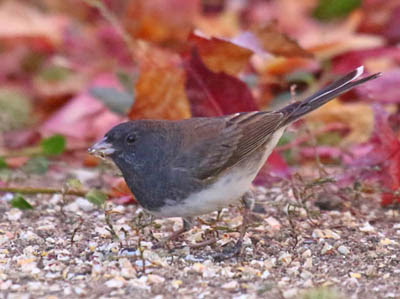 |
| Dark-eyed Junco Photo by Greg Gillson |
Dark-eyed Junco
When these little birds descend to the lowlands, then you know winter is on its way!
These birds form flocks in the winter. They spend most of their time on the ground, scratching for seeds, and nervously flashing their white outer tail feathers.
They breed in northern boreal and mixed forests from Alaska across Canada, and also mountain regions of the West and Northeast. In winter they descend and migrate south to wood edges and backyards across most of the United States.
Dark-eyed Juncos breed in extreme northwestern New Jersey, and they winter throughout the state.
Juncos are plump with large heads and short necks. Their tails are medium long, and thin.
The form of junco found in New Jersey is rather all-over dark slate above, with a white lower breast and belly. Females are a bit more brownish on the back. The bill is pink, as are the legs and feet. The tail is blackish with about three white outer tail feathers on each side.
They make constant smacking and ticking notes.
Dark-eyed Juncos like smaller seeds such as white proso millet. They also eat black oil sunflower seeds. They prefer to eat on the ground under the feeder, but will eat from hopper and platform feeders.
 |
| House Sparrow Photo by Greg Gillson |
House Sparrow
This common bird was introduced from Europe to New York in 1850. They spread from there across the North American Continent.
House Sparrows occur in noisy flocks throughout the year.
Cities, farms, and ranches are this birds favorite habitat. They inhabit residential areas, as well.
They are year-round residents across Canada and south through the United States and Mexico, wherever there are people.
House Sparrows are year-round residents in New Jersey.
This is a stocky sparrow with big head and shorter tail. The head is rather flat. The large bill is conical.
These birds are dusty brown above and gray below. Females have a broad pale eyebrow. Males have a gray crown, chestnut nape, and black mask and throat that is more extensive in summer.
Calls include chirrup and chirp notes.
These birds like all kinds of smaller seeds. Because they are noisy and messy, and eat a lot, many people don’t care to attract them to their feeders. They have rather weak feet, so they don’t like tube feeders. Black oil sunflower seeds in tube feeders is the best way to keep numbers down at your feeder.
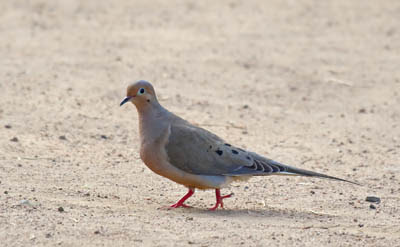 |
| Mourning Dove Photo by Greg Gillson |
Mourning Dove
This very common bird regularly visits bird feeders.
Watch them bob their heads as they walk on the ground!
Mourning Doves are found in a wide variety of habitats, including towns, farms, river bottoms. They summer from southern Canada southward, but leave Canada and the northern reaches in the center of the United States in winter.
Mourning Doves are found year-round in New Jersey.
As with other doves, these are plump birds. The head is small and round. These birds have a long pointed tail. The legs are short.
The coloration of these birds is pale brown, darker on the wings, with a pinkish cast on the breast. There are large black spots on the wings. There are white edges on the outer tail feathers.
In spring these birds give a sad cooing sound. In winter, though, the only sound they are likely to make is the whistling noise of the wings as they fly.
Mourning Doves eat a wide variety of grains and seeds. They will eat black oil sunflower seeds and cracked corn. They prefer to eat on the ground. So they will like a low platform feeder. But they even squeeze up onto small hopper feeders!
 |
| House Finch Photo by Greg Gillson |
House Finch
Well-named birds, they are found wherever there are people living.
These birds are usually found in flocks, flying up into the tops of low trees when disturbed.
In the East, they are often restricted to residential areas. In the West they are also found in arid canyon lands.
House Finches live from southern Canada, south through most of the United States and Mexico.
House Finches are year-round residents throughout New Jersey.
These are compact birds with big heads. They have a slightly longer tail than most other finches, but still rather short. The bill is deep and conical.
The general plumage coloration is gray and dusty brown with darker brown streaks. The under parts are creamy white with dusky streaks. The female doesn’t have much of a pattern on the head, compared with other female finches. The males show a reddish-orange coloration on the upper parts. These are brightest on the forehead, upper breast, and rump.
These birds seem constantly to chirp, a wheat sounding call. They have a wiry, drawn out warbling song that they may sing throughout much of the year.
These birds love black oil sunflower seeds from a tube feeder. They also eat Niger seed from thistle feeders.
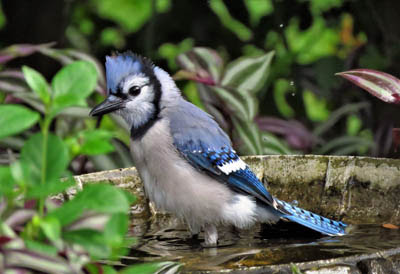 |
| Blue Jay Image by skeeze from Pixabay |
Blue Jay
This is one of the most recognizable birds in the U.S., even though it is restricted to the eastern half of the country. In the West, people often call any other jay (Steller’s Jay and California Scrub-Jay or others) they see a “blue jay.”
These are often brash and noisy birds. They sometimes chase other birds away from the feeder.
Their primary habitat is deciduous woodlands. They fit right in with the shade trees of the suburbs.
They live east of the Rocky Mountains from Canada to the Gulf States. In winter they retreat from much of Canada. During this time you may see large migratory flocks.
Blue Jays are year-round residents in New Jersey.
These are rather large backyard birds. They have a big head and a full tail. The legs and feet are large. The bill is large, stout, long. The crest is a noticeable feature.
Birds are blue above and white below. The crown and crest is blue. The face is white. There is a black necklace across the breast that wraps up around the head. The wings and tail are barred with black and have numerous white spots.
They give numerous whistled and harsh calls, including a jay jay jay call.
At feeders, Blue Jays eat larger seeds and nuts. They are fond of sunflower seeds and peanuts. They eat from platform and hopper feeders. They love suet, too.
They are larger than other feeder birds. They have a large appetite, and may take seeds away from the feeder in fall to bury and eat later in the winter. Thus, many people don’t really care to have them visit their feeders. To deter and discouraging them a bit, use tube feeders for other birds. Place suet in upside-down suet feeders to make it harder for large birds like jays to reach.
 |
| Red-bellied Woodpecker Image by skeeze from Pixabay |
Red-bellied Woodpecker
This woodpecker quickly becomes accustomed to bird feeders. Otherwise they tend to be shy.
They are often solitary. They are active, and at home on all parts of the tree, not just the trunk.
These birds are found in deciduous woods and find shade trees in residential areas to their liking.
These birds are found in the Eastern United States, though generally absent in the area immediately next to the Canadian border.
Red-bellied Woodpeckers are year-round residents throughout New Jersey.
Like other woodpeckers, these have stout bodies. The head is large and the bill as long as the head, chisel-shaped. The tail is short and pointed. The legs are short. The feet large and strong.
These are pale buffy-colored birds with thin black-and-white stripes on the back and wings. There is a red stripe of red from bill to hind neck.
A common call is a rolling churrr.
At your bird feeder Red-bellied Woodpeckers like black oil sunflower seeds, peanuts, and other nuts from platform feeders. They love suet and peanut butter.
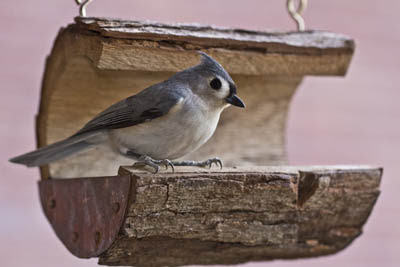 |
| Tufted Titmouse Image by anne773 from Pixabay |
Tufted Titmouse
This bird is a bit larger than chickadees, with which it is related. Like those birds it searches crannies and bark, often hanging acrobatically from twig tips.
These birds are found in deciduous and mixed woods, often high in the canopy. It is found from southern Maine to southern Minnesota and south from Florida to eastern Texas.
Tufted Titmouses are year-round residents in New Jersey.
These birds are a round ball of fluff with a large head. The tails are full, but not as long and active as chickadees. The crest may or may not be obvious with only a brief view. Legs and feet are strong. The bill is short and stout.
They are colored gray above and pale below. The black eye stands out in the middle of the pale face. This is accentuated by black feathers around the eye. These make the eye look bigger than it is. The tell-tale mark is the black forehead.
Winter calls are soft nasal twitters. Sings throughout the year, a loud whistled Peter-Peter-Peter.
Feed Tufted Titmouses black oil sunflower seeds from tube feeders. They also liked bits of peanuts.
 |
| Song Sparrow Photo by Greg Gillson |
Song Sparrow
These birds are abundant in wetlands, but also found in residential backyards with large landscaped shrubs.
They hide in brushy situations, but come out to inquisitively inspect any intruders in their territories.
Found in brushy, weedy, areas, especially in wetlands or stream sides. They breed from Alaska and across Canada, and down both coasts, and the northern two-thirds of the central United States. In winter they move out of Canada and the northernmost interior US to winter throughout most of the US.
Song Sparrows are year-round residents in New Jersey.
These birds are small, rather plump. They have a round head on a short neck. The tail is long and rounded at the tip. The bill is conical, but not overly large.
There are numerous variations in coloration across the continent. Some populations are paler and grayer with sparse breast streaking (such as the form from southern California in the photo above). Others are dark, rusty, and heavily streaked. The head pattern is the same: gray eyebrow, gray cheek patch, white submalar, white throat, all edged with dark brown. The dark lateral throat stripe is especially wide. The breast streaks coalesce into a dense central spot.
These birds call a chimp note and sing throughout most of the year, a lively broken trill with three scratchy (the third drawn out) introductory notes.
Setting up a winter bird feeding station in New Jersey
I usually recommend setting up different kinds of feeders, each with their own food. However, most of the birds in New Jersey would do well with high quality mixed seed in a hopper feeder.
If you don’t have squirrels, then any of the hopper feeders will be fine.
As for mixed bird seed, the one I recommend as best is Wagner’s Songbird Supreme. It is 50% sunflower seeds, both in the shell and broken kernels. Much of the rest is white millet. This combination of seeds is best and will attract the most birds. It has no cheap filler such as red milo or cracked corn. My recently purchased bag has a resealable Velcro-like opening.
This combination of feeder and seed will readily attract all the birds listed above, except the woodpeckers. They may still eat it, but…
To attract the woodpeckers, set up a suet feeder. I really like the Nature’s Way Upside-down suet feeder. It also attracts chickadees, nuthatches, titmouses, wrens, and other smaller birds that might not eat seeds. But larger starlings, blackbirds, jays, and crows have a more difficult time getting to it–even though they try!
Recently I have been impressed with the St. Albans Bay suet blocks that fit in that feeder. Half of these blocks are berry and the other half is peanut. I think birds like either equally well. These are very affordable.
Wrapping Up
Feeding winter birds in New Jersey is important to the birds and brings joy to us humans. Winter can be a challenging time for birds, with natural food sources becoming scarce due to snow and ice cover. Providing feeders with appropriate seeds and fruits can offer them much-needed energy and help them survive through the colder months.
Bird feeders attract a variety of species, allowing you to observe and enjoy these beautiful creatures closer to your home. This can be a relaxing and educational experience for both adults and children.
Some bird species, especially smaller ones, may struggle to find food during winter. Offering feeders can be particularly helpful for these vulnerable populations and contribute to their survival.
Frequently Asked Questions
Where do birds go in the winter in New Jersey?
Where birds go in the winter in New Jersey depends on the species and its individual preferences. Here’s a breakdown of the various strategies birds adopt:
Migration:
-
Southbound journeys: Many New Jersey birds, particularly insectivores and warblers like tanagers, orioles, and thrushes, migrate south to warmer climates, often reaching Central and South America, where food is abundant and temperatures are milder.
-
Examples: Scarlet tanagers, Baltimore orioles, Yellow-rumped warblers, Tennessee warblers, Indigo buntings, White-throated sparrows, Fox sparrows.
Staying put:
-
Year-round residents: Some species, like cardinals, blue jays, chickadees, and some hawks and owls, are permanent residents in New Jersey. They have adapted to find food and shelter throughout the winter months.
-
Examples: Northern cardinals, blue jays, Carolina chickadees, tufted titmice, red-tailed hawks, great horned owls.
Short-distance movements:
-
Within-state relocation: Certain birds, like woodpeckers and some sparrows, may move within New Jersey in the winter, seeking areas with better food availability or shelter from the harshest weather.
-
Examples: Downy woodpeckers, Hairy woodpeckers, Dark-eyed juncos, Song sparrows.
How do birds know to migrate in winter?
Birds are pretty smart and can instinctively tell whether it is best for their survival to stay put or migrate:
- Diet: Birds that rely heavily on insects are more likely to migrate south as their food sources become scarce.
- Temperature tolerance: Species with lower cold tolerance are more likely to migrate or seek sheltered areas within their habitat.
- Habitat suitability: Availability of food, shelter, and water in the winter influences whether a bird stays put or seeks alternative locations.
Where are some good places to go bird watching in winter in New Jersey?
New Jersey offers a surprising variety of excellent birding spots even in the winter months, when many birds migrate south. Here are some top choices depending on your preferred location and target species:
Coastal birding:
- Sandy Hook: This barrier spit stretching into the Atlantic Ocean attracts various waterfowl, shorebirds, and gulls, including Brant, Long-tailed Ducks, Red-throated Loons, Common Murres, and Glaucous Gulls.
- Cape May: Renowned for its spring and fall migrations, Cape May still offers winter birding highlights like Snow Geese, Horned Grebes, Red-breasted Mergansers, and Black Scoters, particularly around the birding observatory and Higbee Beach Wildlife Management Area.
- Barnegat National Wildlife Refuge: Home to salt marshes, freshwater ponds, and barrier islands, this refuge hosts wintering waterbirds like Black Ducks, Gadwalls, American Oystercatchers, and Clapper Rails.
Inland birding:
- Great Swamp National Wildlife Refuge: This vast forested wetland area shelters wintering raptors like Red-tailed Hawks, Northern Harriers, and Eastern Screech-Owls, along with smaller birds like Chickadees, Tufted Titmice, and White-breasted Nuthatches.
- Heislerville Wildlife Management Area: Known for its diverse habitats, Heislerville attracts wintering sparrows like Dark-eyed Juncos, Song Sparrows, and even the occasional Lapland Longspur, along with woodpeckers, owls, and hawks.
- High Point State Park: Offering scenic mountain views and diverse forests, High Point attracts wintering finches like Pine Siskins, Red Crossbills, and Common Redpolls, alongside woodpeckers, kinglets, and nuthatches.
Related Articles:
The most common backyard birds in New Jersey
My recommended bird feeder setup
Bird seeds that attract the most birds
Different kinds of bird feeders for different birds
Bird baths that birds actually use






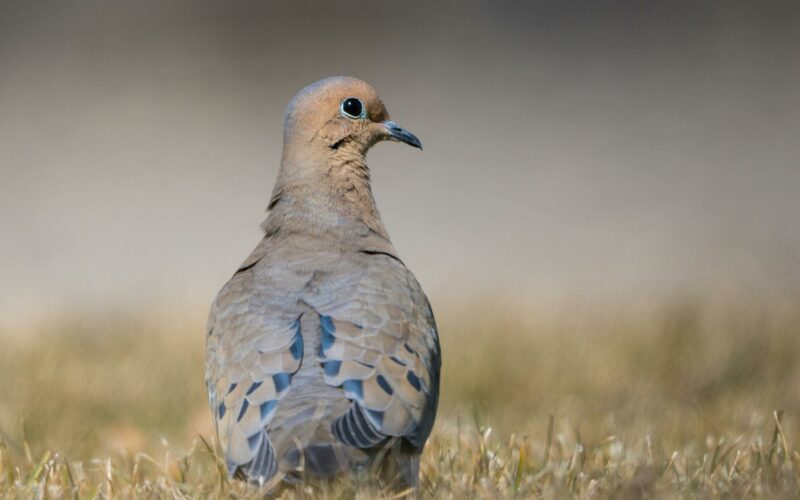
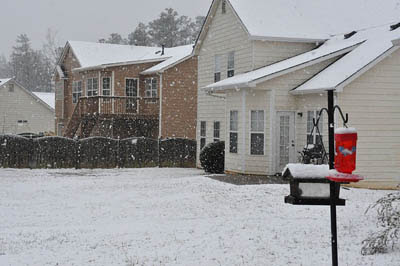
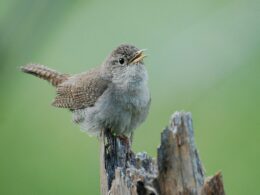
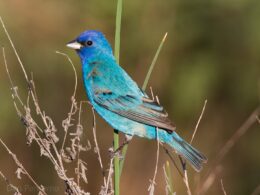
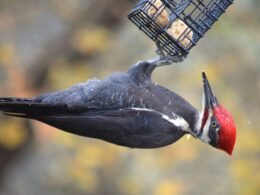
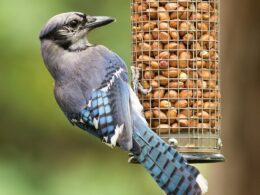
Usually the birds will feed themselves. In animals it is more common to see it eating nuts and storing them rather than small animals like worms, bugs, ect.
Yes, insects are usually scarce in winter.